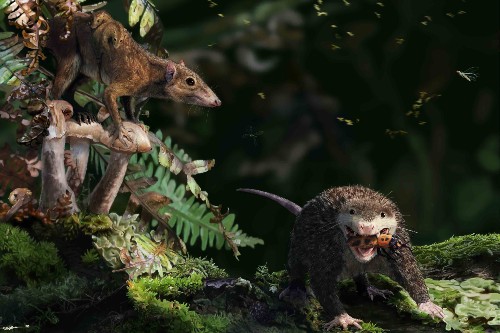
Dryolestes and Haldanodon - Digital reconstruction of two contemporaneous fossil animals studied here, from the Late Jurassic Guimarota fauna (Portugal), which captures aspects of their life histories. To the left is a parent Dryolestes early mammal supporting a brood of young after attaining sexual maturity from four years-of-age. To the right is an ageing Haldanodon docodont non-mammalian mammaliaform, having reached 11 years of age. James Brown
A new study published in Science Advances reveals how early mammals grew and developed during their pivotal Jurassic radiation. Using a technique called synchrotron X-ray tomography to image growth rings in fossilised tooth roots, the researchers were able to estimate lifespans, growth rates, and even the timing of sexual maturity in these ancient creatures.
The team found that the first signs of the modern mammal growth pattern – high growth rates in young animals that are arrested at puberty – originated amongst the earliest true mammals around 130 million years ago. In earlier evolving 'mammaliaforms' there was comparatively little change through life. However, like mammaliaforms, early mammals still grew more slowly and lived for much longer than today's small mammals like rats and mice, reaching maximum lifespans anywhere between eight to 14 years-of-age. The timing of this growth rate change, alongside changes in the structure of growth rings, indicates when these animals underwent puberty, and potentially when they became sexually mature.
The findings challenge previous assumptions about the growth patterns of mammal ancestors, and suggestions that these animals may have grown more similarly to modern mammals. Instead, this paper answers the question posed by similar recent studies of early mammal ancestors: when did the modern mammal life history evolve?
"This data suggests that while living small-bodied mammals are sexually mature within months from birth, the earliest mammals took several years to reach sexual maturity, corroborating recent findings for one of our studied animals, Krusatodon." Said Dr Pam Gill, co-lead of the study, a researcher at University of Bristol's School of Earth Sciences, and Scientific Associate at the Natural History Museum London. "We further find here that this long, drawn out life history was common amongst early mammals all the way through the Jurassic."
"This is the first time we've been able to reconstruct the growth patterns of these early mammals in such detail," said co-lead Dr Elis Newham, Postdoctoral Research Associate at Queen Mary University of London and Alexander von Humboldt Research Fellow at the University of Bonn, first author of the study. "By studying the spacing and texture of these growth rings, we can not only tell how fast they grew at different stages of life, but also make inferences about their metabolism and overall life history.
"These results suggest that the unique life history traits of mammals, like high metabolic rates and extended parental care, evolved gradually over millions of years. The Jurassic period appears to be a pivotal time in this evolution."
The research team used a technique called synchrotron X-ray tomography to image tiny growth rings in fossilized root cementum, the boney tissue attaching teeth to the jaw. These rings are similar to those found in trees, but on a microscopic scale. By counting the rings and analyzing their thickness and texture, the researchers were able to reconstruct the growth patterns and lifespans of these extinct animals.
"This study is a great example of how new technologies are revolutionizing our understanding of the deep past," says Professor Thomas Martin of the University of Bonn, a senior co-author of the study. "By peering into these fossilised teeth, we can gain valuable insights into the lives of creatures that lived millions of years ago."
Paper:
'The origins of mammal growth patterns during the Jurassic mammalian radiation' by Elis Newham, Pamela G. Gill et al. in Science Advances.






